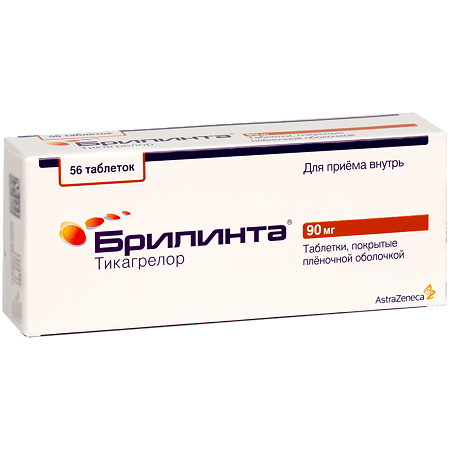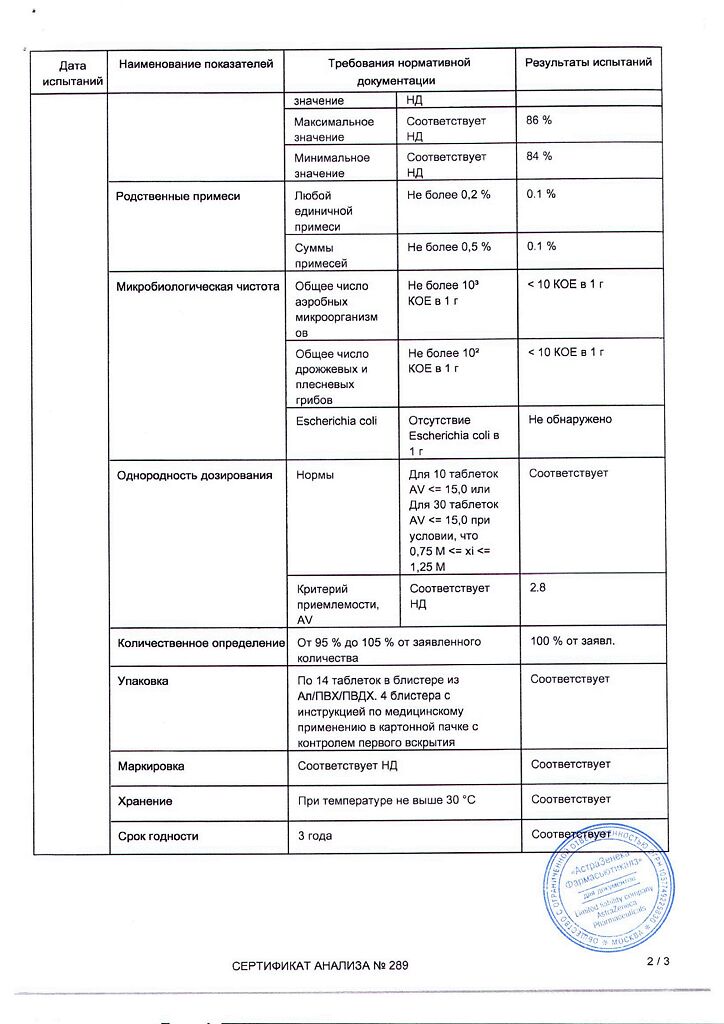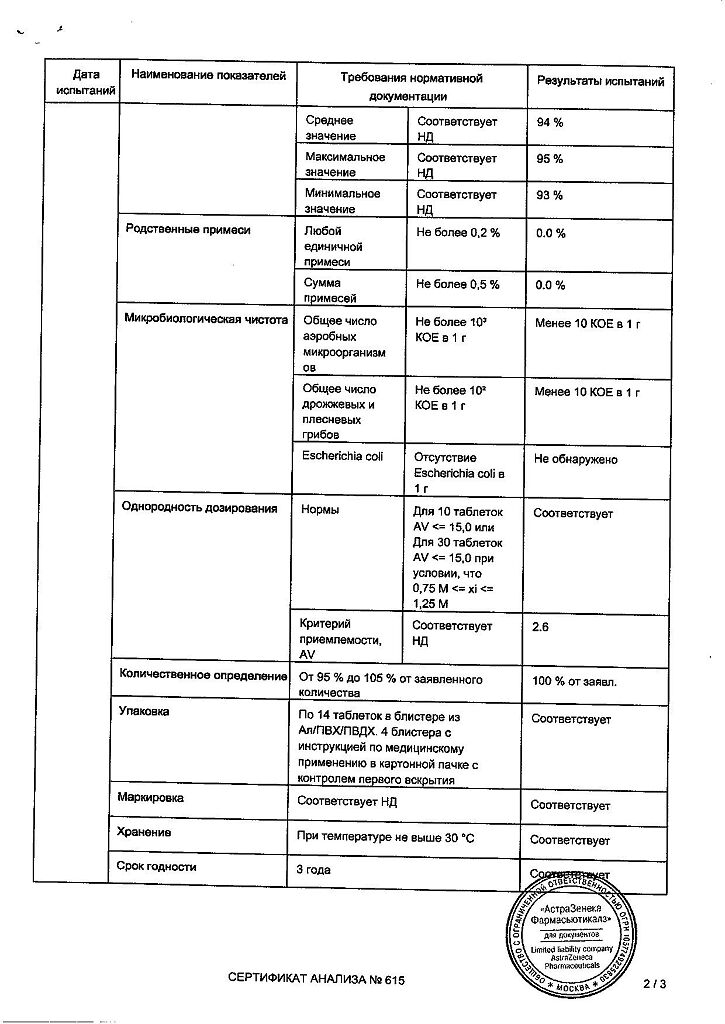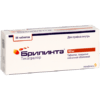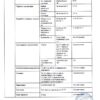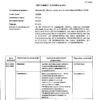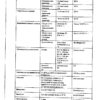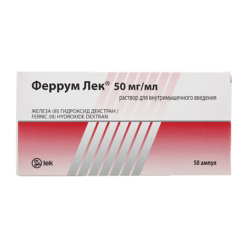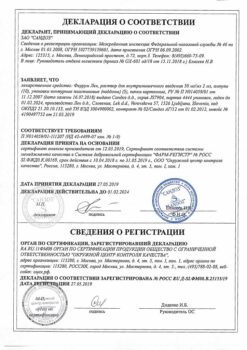No products in the cart.
Brilinta, 90 mg 56 pcs.
€137.99 €114.99
Description
Pharmacotherapeutic group: anti-aggregant
ATX code: B01AC24
Indications
Indications
Brilinta®, used concomitantly with acetylsalicylic acid, is indicated for the prevention of atherothrombotic events in patients with acute coronary syndrome (unstable angina, non-ST-segment elevation myocardial infarction or ST-segment elevation myocardial infarction [STEMI]), including patients receiving drug therapy and patients undergoing percutaneous coronary intervention (PCI) or coronary artery bypass grafting (CABG).
Pharmacological effect
Pharmacological effect
Pharmacotherapeutic group: antiplatelet agent
ATX code: B01AC24
Special instructions
Special instructions
Risk of bleeding
When prescribing Brilinta®, the balance between the benefit of preventing atherothrombotic events and the risk in patients with an increased risk of bleeding should be assessed.
If clinically indicated, Brilinta® should be used with caution in the following patient groups:
Patients predisposed to bleeding (eg, due to recent trauma, recent surgery, bleeding disorders, active or recent gastrointestinal bleeding) or patients at increased risk of injury. The use of Brilinta® is contraindicated in patients with active pathological bleeding, a history of intracranial hemorrhage, or severe liver failure.
Concomitant use of drugs that may increase the risk of bleeding (for example, nonsteroidal anti-inflammatory drugs, oral anticoagulants and/or fibrinolytics taken within 24 hours before taking Brilinta®).
In a study in healthy volunteers, platelet transfusion did not reverse the antiplatelet effect of Brilinta and is likely to have no clinical effect in bleeding patients. Since the concomitant use of Brilinta® and desmopressin did not reduce the standardized bleeding time, it is unlikely that desmopressin will effectively stop bleeding (see section “Interaction with other drugs”).
Antifibrinolytic therapy (aminocaproic acid or tranexamic acid) and/or recombinant factor VIIa may enhance hemostasis. Once the cause of the bleeding has been established and it has been stopped, therapy with Brilinta® can be resumed.
Surgical operations
Before a planned operation or starting to take new medications, the patient should inform the doctor that he is taking Brilinta®.
In the PLATO study, in patients undergoing CABG, Brilinta® was associated with more bleeding compared with clopidogrel when therapy was stopped one day before surgery, but the incidence of major bleeding when therapy was stopped 2 or more days before surgery was similar between the ticagrelor and clopidogrel groups (see Adverse Reactions section). If the patient is undergoing elective surgery and the antithrombotic effect is not desired, then therapy with Brilinta® should be discontinued 5 days before surgery (see section “Pharmacological properties”).
Patients with previous ischemic stroke
Patients with ACS with a previous ischemic stroke can take Brilinta® for up to 12 months (PLATO study).
The PEGASUS trial did not include patients with a history of myocardial infarction with a previous ischemic stroke. Therefore, in the absence of data, therapy for more than 1 year should be carried out with caution.
Patients with liver failure
The use of Brilinta® is contraindicated in patients with severe liver failure (see sections “Contraindications” and “Dosage and Administration”). Caution should be exercised in patients with moderate hepatic impairment, given the limited experience with the drug in patients in this group (see sections “Pharmacokinetics” and “Dosage and Administration”).
Bradyarrhythmia
24-hour Holter ECG monitoring showed an increase in the frequency of mostly asymptomatic ventricular pauses during therapy with ticagrelor compared with clopidogrel. In phase 3 studies assessing the safety and efficacy of Brilinta®, bradyarrhythmia events were recorded with a similar frequency for ticagrelor and comparator drugs (placebo, clopidogrel and ASA). Patients with an increased risk of developing bradycardia (eg, patients without a pacemaker, diagnosed with sick sinus syndrome, 2nd or 3rd degree atrioventricular heart block, or syncope associated with bradycardia) were excluded from the Brilinta outcome studies. Therefore, due to limited clinical experience with the use of the drug in these patients, it is recommended to prescribe Brilinta® to them with caution (see also section “Pharmacological properties”).
Caution should also be exercised when using Brilinta® together with drugs that can cause bradycardia. However, in the PLATO study, there were no clinically significant side effects when used concomitantly with one or more drugs that can cause bradycardia (for example, 96% of patients were concomitantly taking beta-blockers, 33% taking calcium channel blockers, including diltiazem and verapamil, and 4% taking digoxin) (see section “Interactions with other drugs”). In a substudy using 24-hour Holter ECG monitoring, more patients in the acute phase of ACS had ventricular pauses ≥ 3 seconds in the ticagrelor group compared with clopidogrel. An increase in the number of ventricular pauses recorded using 24-hour Holter monitoring while taking ticagrelor was observed more often in patients with chronic heart failure compared to the general population in the acute phase of ACS, but not in the first month of therapy and not compared with clopidogrel. Pauses in these patients were not accompanied by subsequent undesirable clinical consequences (syncope and pacemaker installation).
During post-marketing use of Brilinta®, cases of bradyarrhythmia and atrioventricular block were noted (see section “Side Effects”), mainly in patients with ACS, in which myocardial ischemia and concomitant use of drugs that reduce heart rate or affect conduction could potentially have an effect. The patient’s clinical condition and concomitant medications should be assessed as potential causes before therapy is adjusted.
Dyspnea
Dyspnea has been reported in patients taking Brilinta®. Shortness of breath when using Brilinta® is usually mild or moderate in intensity and often goes away as drug therapy is continued. Patients with bronchial asthma/COPD may have an increased absolute risk of shortness of breath while taking Brilinta® (see section “Side effects”). In patients with asthma/COPD, ticagrelor should be used with caution. The mechanism of shortness of breath while taking ticagrelor is not clear. If the patient develops a new episode of shortness of breath, shortness of breath persists or worsens while using Brilinta®, then a full examination should be carried out, and in case of intolerance, the drug should be discontinued.
Central sleep apnea
Cases of central sleep apnea, including Cheyne-Stokes respiration, have been reported with post-marketing use of Brilinta®. If central sleep apnea is suspected, the need for further clinical evaluation should be assessed.
Increased creatinine concentration
During therapy with Brilinta®, the concentration of creatinine may increase (see section “Side effects”). The mechanism of this effect is unknown. In patients with ACS, assessment of renal function should be carried out one month after starting the drug, and thereafter in accordance with routine clinical practice, paying special attention to patients aged 75 years and older, patients with moderate or severe renal impairment and receiving therapy with angiotensin II receptor antagonists.
Increased uric acid concentration
During therapy with Brilinta®, the concentration of uric acid may increase (see section “Side effects”). Caution should be exercised in patients with a history of hyperuricemia or gouty arthritis. As a preventive measure, the use of ticagrelor should be avoided in patients with hyperuricemic nephropathy.
Thrombotic thrombocytopenic purpura (TTP)
TTP during the use of Brilinta® was observed very rarely. TTP is a serious condition and requires immediate treatment.
Effect on laboratory test results
Platelet function analysis as part of the diagnosis of heparin-induced thrombocytopenia (HIT)
False-negative platelet function test results for the diagnosis of heparin-induced thrombocytopenia (HIT) have been reported in patients taking ticagrelor. This is due to the inhibition of P2Y12 receptors by ticagrelor on platelets from healthy donors when tested in the patient’s serum/plasma. When interpreting the results of platelet function tests as part of the diagnosis of HIT, information about concomitant therapy with ticagrelor should be taken into account.
Before considering discontinuation of ticagrelor, the benefits and risks of continuing therapy should be assessed, taking into account both the prothrombotic state due to HIT and the increased risk of bleeding during co-administration of the anticoagulant and ticagrelor.
Other
Based on the association observed in the PLATO study between the maintenance dose of ASA and the effectiveness of ticagrelor compared with clopidogrel, co-administration of a high maintenance dose of ASA (more than 300 mg) and Brilinta is not recommended.
Concomitant use of Brilinta® with strong CYP3A4 inhibitors (for example, ketoconazole, clarithromycin, nefazodone, ritonavir and atazanavir) is contraindicated (see section “Contraindications”), as it may lead to a significant increase in the exposure of Brilinta® (see section “Interactions with other drugs”).
Concomitant use of Brilinta® with strong CYP3A4 inducers (for example, rifampicin, phenytoin, carbamazepine and phenobarbital) is not recommended, as their combined use may reduce the exposure and effectiveness of ticagrelor (see section “Interaction with other drugs”).
Co-administration of Brilinta® with CYP3A4 substrates with a narrow therapeutic index (for example, cisapride and ergot alkaloids) is not recommended as ticagrelor may increase the exposure of these drugs. The combined use of Brilinta® with simvastatin or lovastatin at a dose of more than 40 mg is not recommended (see section “Interaction with other drugs”).
When using digoxin and Brilinta® together, careful clinical and laboratory monitoring (heart rate, and, if clinically indicated, also ECG and digoxin concentration in the blood) is recommended.
There are no data on the combined use of ticagrelor with strong P-glycoprotein inhibitors and moderate CYP3A4 inhibitors (for example, verapamil and quinidine), which may increase the exposure of ticagrelor. If their combined use cannot be avoided, it should be used with caution (see sections “With caution”, “Interaction with other drugs”).
Discontinuation of therapy
Early discontinuation of any antiplatelet therapy, including Brilinta, may increase the risk of cardiovascular death, myocardial infarction, or stroke as a result of the underlying disease. Premature discontinuation of the drug should be avoided.
Impact on the ability to drive vehicles and machinery
There have been no studies of the effect of Brilinta® on the ability to drive vehicles and operate machinery. Brilinta® does not affect or only slightly affects the ability to drive vehicles and operate machinery. Dizziness and confusion have been reported during drug therapy. In case of development of these phenomena, patients should be careful when driving a car and other mechanisms.
Active ingredient
Active ingredient
Ticagrelor
Composition
Composition
Composition per 1 tablet:
Active ingredient: ticagrelor 90 mg
Excipients: mannitol 126 mg, calcium hydrogen phosphate 63 mg, sodium carboxymethyl starch 9 mg, hyprolose 9 mg, magnesium stearate 3 mg;
film-coated tablets: hypromellose 2910 5.6 mg, titanium dioxide E 171 1.7 mg, talc 1.0 mg, macrogol 400 0.6 mg, iron dye yellow oxide E 172 0.1 mg.
Pregnancy
Pregnancy
Women of reproductive age
Women of reproductive potential should use appropriate methods of contraception to avoid pregnancy during therapy with Brilinta®.
Pregnancy
There are no or limited data on the use of Brilinta® in pregnant women.
In animal studies, ticagrelor caused a slight decrease in maternal weight gain, a decrease in the viability of the newborn and its body weight, and growth retardation. Brilinta® is not recommended during pregnancy.
Breastfeeding period
Available pharmacodynamic and toxicological data in animals have shown that ticagrelor and its active metabolites are excreted in milk. A risk to the newborn/infant cannot be excluded. It is not recommended to use Brilinta® while breastfeeding.
Fertility
Ticagrelor had no effect on the fertility of male and female animals.
Contraindications
Contraindications
• Hypersensitivity to ticagrelor or any of the components of the drug
• Active pathological bleeding
• History of intracranial hemorrhage
• Severe liver failure
• Concomitant use of ticagrelor with strong CYP3A4 inhibitors (for example, ketoconazole, clarithromycin, nefazodone, ritonavir and atazanavir)
• Children under 18 years of age (due to the lack of data on the effectiveness and safety of use in this group of patients)
• Pregnancy and breastfeeding
With caution
Predisposition to bleeding (eg, due to recent trauma, recent surgery, bleeding disorders, active or recent gastrointestinal bleeding) or increased risk of injury (see
section “Special instructions”).
Concomitant therapy with drugs that increase the risk of bleeding (i.e., non-steroidal anti-inflammatory drugs, oral anticoagulants and/or fibrinolytics) within 24 hours before taking Brilinta®.
Patients with moderate liver failure.
Patients at increased risk of developing bradycardia (eg, patients without a pacemaker with sick sinus syndrome, 2nd or 3rd degree atrioventricular block, syncope associated with bradycardia); combined use with drugs that cause bradycardia (see section “Special instructions”).
Patients with bronchial asthma and chronic obstructive pulmonary disease (COPD).
Patients aged 75 years and older; patients with moderate or severe renal impairment; patients receiving therapy with angiotensin II receptor antagonists.
Patients with hyperuricemia or gouty arthritis.
Concomitant therapy with digoxin; potent inhibitors of glycoprotein P and moderate inhibitors of the CYP3A4 isoenzyme (for example, verapamil or quinidine); selective serotonin reuptake inhibitors (for example, paroxetine, sertraline and citalopram); drugs that affect hemostasis (see section “Interaction with other drugs”).
Side Effects
Side Effects
Security Profile at a Glance
The safety profile of Brilinta® was studied in two large outcome studies (PLATO and PEGASUS), which involved more than 39,000 patients (see section “Pharmacodynamics”).
In the PLATO study, patients receiving Brilinta® were more likely to discontinue therapy due to adverse events than patients receiving clopidogrel (7.4% versus 5.4%). In the PEGASUS study, patients receiving Brilinta® had a higher rate of discontinuation due to adverse events than patients receiving ASA monotherapy (16.1% in the ticagrelor 60 mg plus ASA group and 8.5% in the ASA monotherapy group). The most common adverse events in patients taking ticagrelor were bleeding and shortness of breath (see also section “Special Instructions”). The following are the adverse reactions noted in these studies.
List of adverse reactions
Adverse reactions noted in clinical studies or during post-marketing use of Brilinta® are distributed by organ system class and frequency of development. The frequency of adverse reactions is determined using the following categories: very often (≥1/10), often (≥1/100, <1/10), infrequently (≥1/1000, <1/100), rarely (≥1/10000, <1/1000), very rarely (<1/10000), unspecified frequency (cannot be estimated from the data obtained).
System class
organs
Very
often
Often
Uncommon
Frequency
unknown
Benign, malignant and unspecified neoplasms
(including cysts and
polyps)
Bleeding from a tumor2
Blood and lymphatic system disorders
Bleeding associated with diseases
blood3
Thrombotic thrombocytopenic purpura13
Immune system disorders
Hypersensitivity, including angioedema
chelic edema13
Exchange violations
substances and nutrition
Hyperuricemia1
Gout/ gouty
cue arthritis
Mental disorders
Confusion
consciousness
Nervous system disorders
Dizziness, fainting, headache
Intracranial hemorrhage12
Central sleep apnea, including
Cheyne’s breath
Stokes13
Violations with
sides of the organ of vision
Hemorrhage in the eye4
Hearing and labyrinthine disorders
violations
Vertigo
Hemorrhage in the ear
Heart disorders
Bradyarrhythmia13, atrioventricular
blockade13
Violations with
sides of vessels
Arterial
hypotension
Violations by
respiratory system, chest organs and
mediastinum
Dyspnea
Bleeding from the respiratory system5
Gastrointestinal disorders
intestinal tract
Gastrointestinal bleeding6, diarrhea, nausea, dyspepsia,
constipation
Retroperitoneal bleeding
Skin and subcutaneous tissue disorders
Subcutaneous or cutaneous hemorrhage7, skin itching,
skin rash13
Musculoskeletal and connective tissue disorders
fabrics
Hemorrhage into muscles8
Renal and urinary disorders
ways
Bleeding from the urinary tract9
Disorders of the genital organs and breast
glands
Bleeding from the genital tract10
Laboratory and instrumental data
Increased creatinine concentration in
blood1
Injuries, intoxications and complications of manipulations
Bleeding after manipulation, traumatic bleeding
currents11
The frequency of laboratory abnormalities (increased uric acid concentration above the upper limit of normal from a baseline value that was within the normal range or less than the lower limit of normal; increase in creatinine concentration > 50% of the baseline value) is reported rather than the frequency of reports of adverse events.
For example, bleeding from a tumor (cancer) of the bladder, from a tumor (cancer) of the stomach, from a tumor (cancer) of the colon.
For example, a tendency to bruise, spontaneous hematoma, hemorrhagic diathesis.
For example, conjunctival, retinal, intraocular hemorrhage.
For example, epistaxis (nosebleeds), hemoptysis.
For example, bleeding from the gums, rectal bleeding, bleeding from stomach ulcers.
For example, ecchymosis, skin hemorrhage, petechiae.
For example, hemarthrosis, hemorrhage into the muscle.
For example, hematuria, hemorrhagic cystitis.
For example, vaginal bleeding, hematospermia, postmenopausal bleeding.
For example, bruise, traumatic hematoma, traumatic bleeding.
Those. spontaneous, procedure-related, or traumatic intracranial hemorrhage.
Noted during post-marketing use.
Description of some adverse reactions
Bleeding
The following definitions of bleeding were used in the PLATO and PEGASUS studies:
Major lethal/life-threatening bleeding according to PLATO definition: lethal, or any intracranial hemorrhage, or bleeding into the pericardial cavity with cardiac tamponade; or hypovolemic shock or severe hypotension caused by bleeding and requiring the use of vasoconstrictors/inotropes or surgery, or clinically overt bleeding accompanied by a decrease in hemoglobin concentration of more than 50 g/L or a transfusion of 4 or more units of red blood cells.
Major other bleeding as defined by PLATO: causing significant disability of the patient, or clinically obvious bleeding, accompanied by a decrease in hemoglobin level by 30-50 g/L, or requiring a transfusion of 2-3 units of whole blood or red blood cells.
Minor bleeding as defined by PLATO: requires medical intervention to stop or treat the bleeding.
Major bleeding as defined by TIMI: fatal, or any intracranial hemorrhage, or clinically overt bleeding associated with a decrease in hemoglobin concentration of 50 g/L or more, or, if hemoglobin concentration data are not available, a decrease in hematocrit of ≥ 15%.
Major other bleeding by TIMI definition: non-fatal, non-intracranial major bleeding by definition
Minor bleeding according to TIMI definition: clinically obvious bleeding, accompanied by a decrease in hemoglobin level by 30-50 g/l.
Bleeding requiring medical attention, as defined by TIMI, requires medical attention or results in hospitalization or urgent evaluation.
Lethal bleeding: leads to the death of the patient within 7 days.
Data on bleeding events in the PLATO study (Kaplan-Meier estimate (%) at 12 months)
Brilinta® and clopidogrel did not differ in the incidence of major bleeding overall according to PLATO criteria (11.6% and 11.2%, respectively), or fatal/life-threatening bleeding according to PLATO criteria (5.8% in both groups). However, the incidence of combined major and minor bleeding according to PLATO criteria was higher in the ticagrelor group (16.1%) compared with clopidogrel (14.6%, p = 0.0084). There were several cases of fatal bleeding: 20 (0.2% of patients) in the ticagrelor group and 23 (0.3% of patients) in the clopidogrel group.
Age, sex, weight, race, geographic region, comorbidities, concomitant medications, and medical history, including previous stroke and transient ischemic attack, did not affect the incidence of overall and nonprocedure-related major bleeding according to PLATO criteria. No groups were identified with an increased risk of bleeding.
CABG-Related Bleeding: In the PLATO study, 42% of 1584 patients (12% of the cohort) undergoing CABG experienced major fatal/life-threatening bleeding, with no significant difference in either treatment group. Fatal bleeding associated with CABG surgery occurred in 6 patients in each treatment group (see section “Special Instructions”).
Non-CABG Bleeding and Non-Procedure-Related Bleeding: Brilinta® and clopidogrel did not differ in the incidence of non-CABG major fatal/life-threatening bleeding as determined by PLATO criteria, but Brilinta® was more likely to experience major bleeding overall as defined by PLATO (4.5% vs. 3.8%; p=0.0264). When removing procedure-related bleeding events, there were more bleeding events in the ticagrelor group (3.1%) than in the clopidogrel group (2.3%; P = 0.0058). Discontinuation due to non-procedure-related bleeding was more common with ticagrelor (2.9%) compared with clopidogrel (1.2%, p < 0.001).
Intracranial hemorrhage: More non-procedure-related intracranial hemorrhage occurred in the ticagrelor group (n=27 bleeds in 26 patients, 0.3%) than in the clopidogrel group (n=14 bleeds, 0.2%), of which 11 bleeds on ticagrelor and 1 on clopidogrel were fatal. However, there was no significant difference in the total number of fatal bleeding events.
Data on bleeding events in the PEGASUS study (Kaplan-Meier estimate (%) at 36 months)
In the PEGASUS-TIMI 54 study, major bleeding as defined by TIMI occurred more frequently with Brilinta® 60 mg twice daily (2.3%) than with ASA monotherapy (1.1%). There was no increased risk of fatal bleeding; There was only a slight increase in the incidence of intracranial hemorrhage (0.6%) compared with ASA monotherapy (0.5%). Several cases of fatal bleeding were noted: 11 (0.3%) in the Brilinta® 60 mg group and 12 (0.3%) in the ASA monotherapy group. The increased risk of major TIMI bleeding with Brilinta 60 mg was primarily due to a higher incidence of other TIMI bleeding due to gastrointestinal events.
With the use of Brilinta® 60 mg, there was an increase in the frequency of major or minor bleeding according to the TIMI definition (3.4% with Brilinta® 60 mg compared to 1.4% with ASA monotherapy), major bleeding according to the PLATO definition (3.5% compared to 1.4%) and major or minor bleeding according to the PLATO definition (15.2% compared to 6.2%). Discontinuation of therapy due to bleeding was more common with Brilinta 60 mg than with ASA monotherapy (6.2% and 1.5%, respectively). Most of these bleeds were less severe (classified as bleeds requiring medical attention, as defined by TIMI), such as epistaxis, bruising, and hematomas.
The profile of TIMI major bleeding, TIMI major or minor bleeding, and PLATO major bleeding with Brilinta 60 mg was comparable across several prespecified subgroups (eg, age, sex, weight, race, geographic region, comorbidities, concomitant medications, and medical history).
Intracranial hemorrhage: spontaneous intracranial hemorrhage was noted with a similar frequency when using Brilinta® 60 mg and ASA monotherapy (13 cases, 0.2% in each treatment group). The incidence of intracranial hemorrhage due to trauma or procedure was slightly higher in the Brilinta 60 mg group (15 cases, 0.2%) compared with ASA monotherapy (10 cases, 0.1%). There were 6 fatal intracranial hemorrhages when taking Brilinta® 60 mg and 5 lethal intracranial hemorrhages when taking ASA monotherapy. The incidence of intracranial hemorrhage was low in both treatment groups, given the significant comorbidities and risk factors for cardiovascular complications in the study population.
Dyspnea
In the PLATO study, adverse events of dyspnea (dyspnea, dyspnea at rest, dyspnea on exertion, paroxysmal nocturnal dyspnea, and nocturnal dyspnea) occurred in 13.8% of patients receiving Brilinta 90 mg twice daily and in 7.8% of patients receiving clopidogrel 75 mg once daily. The researchers estimated that 2.2% of patients in the ticagrelor group had treatment-related shortness of breath. Most cases of shortness of breath were mild or moderate in intensity and often resolved without discontinuation of therapy. Typically, shortness of breath developed at the beginning of therapy and in 87% of patients it occurred as a single episode. Dyspnea as a serious adverse event was reported in 0.7% of patients receiving ticagrelor and in 0.4% of patients receiving clopidogrel.
Patients who developed dyspnea were older and often had dyspnea, chronic heart failure, COPD or bronchial asthma before starting ticagrelor therapy. Data from the PLATO trial do not indicate that higher rates of dyspnea with Brilinta are associated with the development of new or worsening heart or lung disease. Brilinta® does not affect respiratory function parameters (see section “Special instructions”).
In the PEGASUS study, shortness of breath was observed in 14.2% of patients receiving Brilinta 60 mg twice daily and in 5.5% of patients receiving ASA monotherapy. As in the PLATO study, most cases of dyspnea were mild to moderate (see section “Special Instructions”).
Laboratory and instrumental data
Increased uric acid concentrations: In the PLATO study, serum uric acid concentrations increased above the upper limit of normal in 22% of patients receiving ticagrelor compared with 13% of patients receiving clopidogrel. The corresponding numbers in the PEGASUS study were 9.1%, 8.8% and 5.5% in the ticagrelor 90 mg, 60 mg and placebo groups, respectively. Mean serum uric acid concentrations increased by approximately 15% with ticagrelor compared with approximately 7.5% with clopidogrel, and after discontinuation of therapy decreased to approximately 7% in the ticagrelor group, with no decrease in the clopidogrel group. In the PEGASUS study, there was a reversible increase in mean serum uric acid concentrations of 6.3% and 5.6% with ticagrelor 90 mg and 60 mg, respectively, compared with a 1.5% decrease in the placebo group. In the PLATO study, the incidence of gouty arthritis was 0.2% with ticagrelor versus 0.1% with clopidogrel. The incidence of gout/gouty arthritis in the PEGASUS study was 1.6%, 1.5% and 1.1% in the ticagrelor 90 mg, 60 mg and placebo groups, respectively.
Also, when using the drug Brilinta®, the following were noted:
undesirable reactions, the connection of which with taking the drug cannot be excluded taking into account the mechanism of action of ticagrelor: thrombocytopenia, immune thrombocytopenic purpura, thrombocytosis, coagulopathy, pulmonary embolism;
undesirable reactions, probably representing manifestations of hypersensitivity to the drug: urticaria, dermatitis;
undesirable reactions, the connection of which with taking the drug has not been established: hemoconcentration, increased hematocrit, decreased hemoglobin, anxiety, restlessness, insomnia, ischemic stroke, tremor, aphonia, dysphonia, tachycardia, arterial hypertension, chest pain, cardiac arrhythmias (including atrial fibrillation, ventricular extrasystole), cardiac conduction disturbances, peripheral edema, cough, asthma, bronchospasm, gastritis (including erosive), stomach ulcer, epigastric pain, pancreatitis, acute renal failure, arthralgia, myalgia, asthenia, malaise, increased concentration of bilirubin in the blood.
Interaction
Interaction
Impact of other drugs on Brilinta® Drugs metabolized by the CYP3A4 isoenzyme CYP3A4 inhibitors
Potent CYP3A4 inhibitors: Coadministration of ketoconazole with ticagrelor increases the Cmax and AUC of ticagrelor by 2.4 and 7.3 times, respectively. Cmax and AUC of the active metabolite are reduced by 89% and 56%, respectively. Other strong CYP3A4 inhibitors (clarithromycin, nefazodone, ritonavir and atazanavir) will have the same effects, so their combined use with Brilinta® is contraindicated (see sections “Contraindications”, “Special Instructions”).
Moderate inhibitors of CYP3A4: co-administration of diltiazem with ticagrelor increases the Cmax of ticagrelor by 69% and the AUC by 2.7 times, and reduces the Cmax of the active metabolite by 38%, and the AUC does not change. Ticagrelor does not affect plasma concentrations of diltiazem. Other moderate CYP3A4 inhibitors (eg, amprenavir, aprepitant, erythromycin, fluconazole) can also be co-administered with Brilinta.
Cyclosporine (P-gp and CYP3A4 inhibitor)
Co-administration of cyclosporine (600 mg) with ticagrelor increases the Cmax and AUC of ticagrelor by 2.3 and 2.8 times, respectively. At the same time, there is an increase in the AUC of the active metabolite by 32% and a decrease in Cmax by 15%. Ticagrelor does not affect plasma concentrations of cyclosporine.
CYP3A4 inducers
Coadministration of rifampicin with ticagrelor reduced the Cmax and AUC of ticagrelor by 73% and 86%, respectively. The Cmax of the active metabolite does not change, and the AUC decreases by 46%. Other CYP3A4 inducers (eg, phenytoin, carbamazepine and phenobarbital) are likely to reduce the exposure of Brilinta. Potent inducers of CYP3A4 may reduce the exposure and effectiveness of Brilint®.
Other
According to the results of pharmacological interaction studies, concomitant use of ticagrelor with heparin, enoxaparin and ASA or desmopressin does not affect the pharmacokinetics of ticagrelor, its active metabolite and ADP-dependent platelet aggregation. If there are clinical indications for the use of drugs that affect hemostasis, they should be used with caution in combination with Brilinta® (see section “With caution”).
There are no data on the combined use of Brilinta with strong P-glycoprotein inhibitors and moderate CYP3A4 inhibitors (for example, verapamil and quinidine), which may increase the exposure of ticagrelor. If their combined use cannot be avoided, it should be used with caution (see sections “With caution”, “Special instructions”).
Delayed and decreased exposure to oral P2Y12 inhibitors, including ticagrelor and its active metabolite, was observed in patients treated with morphine (approximately 35% decrease in ticagrelor exposure). This interaction may be due to decreased gastrointestinal motility and therefore applies to other opioids. The clinical significance is unknown, but data indicate the potential for decreased efficacy of ticagrelor in patients receiving ticagrelor and morphine concomitantly. In patients with ACS in whom morphine cannot be delayed and rapid P2Y12 inhibition is considered critical, the use of a parenteral P2Y12 inhibitor may be considered.
Effect of Brilinta® on other drugs
Drugs metabolized by the CYP3A4 isoenzyme
Simvastatin: Concomitant use of ticagrelor and simvastatin increases the Cmax and AUC of simvastatin by 81% and 56%, respectively, and increases the Cmax and AUC of simvastatin acid by 64% and 52%, respectively, with, in some cases, these indicators increasing by 2-3 times. Concomitant use of simvastatin at a dose higher than 40 mg/day. with ticagrelor may lead to the development of side effects of simvastatin, and the balance of potential risk and benefit must be assessed. The combined use of Brilinta® with simvastatin and lovastatin at a dose exceeding 40 mg is not recommended.
Atorvastatin: Concomitant use of atorvastatin and ticagrelor increases the Cmax and AUC of atorvastatin acid by 23% and 36%, respectively. A similar increase in Cmax and AUC values is observed for all metabolites of atorvastatin acid. These changes were considered clinically insignificant.
Similar effects on other statins metabolized by CYP3A4 cannot be excluded. In the PLATO trial, patients receiving ticagrelor took various statins, with no safety concerns reported in 93% of patients taking this group of drugs.
Ticagrelor is a weak inhibitor of CYP3A4. Co-administration of Brilinta with CYP3A4 substrates with a narrow therapeutic index (eg, cisapride or ergot alkaloids) is not recommended as ticagrelor may increase the exposure of these drugs.
Drugs metabolized by the CYP2C9 isoenzyme
Concomitant use of ticagrelor and tolbutamide did not change plasma concentrations of either drug, suggesting that ticagrelor is not a CYP2C9 inhibitor and is unlikely to affect the CYP2C9-mediated metabolism of drugs like warfarin and tolbutamide.
Oral contraceptives
Concomitant use of ticagrelor, levonorgestrel and ethinyl estradiol increases the exposure of ethinyl estradiol by approximately 20%, but does not affect the pharmacokinetics of levonorgestrel. No clinically significant effect on the effectiveness of contraception is expected with the simultaneous use of levonorgestrel, ethinyl estradiol and Brilinta®.
P-gp substrates (including digoxin and cyclosporine)
Concomitant use of digoxin with ticagrelor increased the Cmax and AUC of digoxin by 75% and 28%, respectively. When co-administered with ticagrelor, the mean lowest digoxin concentration increased by 30%, in some individual cases twice as much. Cmax and AUC of ticagrelor did not change with digoxin. Therefore, it is recommended to carry out appropriate clinical and/or laboratory monitoring during simultaneous use of Brilinta® and P-gp-dependent drugs with a narrow therapeutic index, such as digoxin and cyclosporine.
There was no effect of ticagrelor on the concentration of cyclosporine in the blood. The effect of ticagrelor on other P-gp substrates has not been studied.
Medicines that can cause bradycardia
When using Brilinta® together with drugs that can cause bradycardia, caution should be exercised. However, in the PLATO study, no clinically significant adverse events were observed when coadministered with one or more drugs that can cause bradycardia (for example, 96% of patients were concomitantly taking beta-blockers, 33% were taking calcium channel blockers, including diltiazem and verapamil, and 4% were taking digoxin).
Other concomitant therapy
In clinical studies, Brilinta® was predominantly prescribed in combination with ASA, proton pump inhibitors, statins, beta-blockers, angiotensin-converting enzyme inhibitors and angiotensin II receptor antagonists for long-term use, as well as with heparin, low molecular weight heparins, and glycoprotein IIb/IIIa receptor inhibitors for intravenous administration in short-term therapy. The results of these studies did not reveal clinically significant adverse interactions.
Co-administration of Brilinta® with heparin, enoxaparin or desmopressin had no effect on activated partial thromboplastin time (APTT), activated clotting time (ACT) and factor Xa studies, however, due to potential pharmacodynamic interactions, caution is required when combined with drugs that affect hemostasis.
Due to reports of subcutaneous hemorrhage with selective serotonin reuptake inhibitors (eg, paroxetine, sertraline and citalopram), caution is recommended when co-administering them with Brilinta.
With daily consumption of large volumes of grapefruit juice (200 ml 3 times a day), a 2-fold increase in ticagrelor exposure was noted. This increase in ticagrelor exposure is not expected to be clinically significant in most patients.
Overdose
Overdose
Ticagrelor is well tolerated in a single dose of up to 900 mg. In the only dose-escalation study, gastrointestinal adverse effects were dose-limiting. Other clinically significant adverse events that could occur with overdose were shortness of breath and ventricular pauses. In case of overdose, it is recommended to monitor for these adverse effects and perform ECG monitoring.
Currently, there is no known antidote to eliminate the effects of ticagrelor; ticagrelor is not eliminated by hemodialysis (see section “Pharmacokinetics”). In case of overdose, symptomatic therapy should be carried out in accordance with local standards. Due to platelet inhibition, increased bleeding time is an expected pharmacological effect of Brilinta overdose. If bleeding develops, appropriate supportive measures must be taken.
Storage conditions
Storage conditions
At a temperature not exceeding 30 °C, out of the reach of children.
Shelf life
Shelf life
3 years. Do not use after expiration date.
Manufacturer
Manufacturer
AstraZeneca Industries/AstraZeneca AB, Russia
Additional information
| Shelf life | 3 years. Do not use after the expiration date. |
|---|---|
| Conditions of storage | At a temperature not exceeding 30 ° C, out of the reach of children. |
| Manufacturer | AstraZeneca Industries/AstraZeneca AB, Russia |
| Medication form | pills |
| Brand | AstraZeneca Industries/AstraZeneca AB |
Related products
Buy Brilinta, 90 mg 56 pcs. with delivery to USA, UK, Europe and over 120 other countries.

